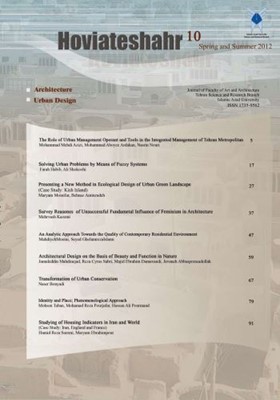-
-
List of Articles
-
Open Access Article
1 - The Role of Urban Management Operant and Tools in the Integrated Management of Tehran Metropolitan
Mohammad Mehdi Azizi Mohammad Aboyee Ardakan , Nasrin Nouri -
Open Access Article
2 - Solving Urban Problems by Means of Fuzzy Systems
farah habib Dr Ali Shokoohi -
Open Access Article
3 - Presenting a New Method in Ecological Design of Urban Green Landscape (Case Study: Kish Island)
Maryam Moinifar Behnaz Aminzadeh -
Open Access Article
4 - Survey Reasones of Unsuccessful Fundametal Influance of Feminism in Architecture
Mehrvash Kazemi -
Open Access Article
5 - An Analytic Approach Towards the Quality of Contemporary Residential Environment
Mahdieh Moeini Seyed Gholamreza Islami, -
Open Access Article
6 - Architectural Design on the Basis of Beauty and Function in Nature
جمال الدین مهدى نژاد رضاسیروس صبرى مجیدابراهیم دماوندى جوانه عباس پوراسداله -
Open Access Article
7 - Transformation of Urban Conservation
naser bonyadi -
Open Access Article
8 - Identity and Place; Phenomenological Approach
mohsen taban Mohamad Reza Pourjafar , Hassan Ali Pourmand -
Open Access Article
9 - Studying of Housing Indicators in Iran and World (Case Study: Iran, England and France)
حمیدرضا صارمى مریم ابراهیم پور
-
The rights to this website are owned by the Raimag Press Management System.
Copyright © 2021-2025







